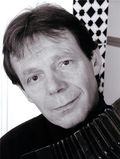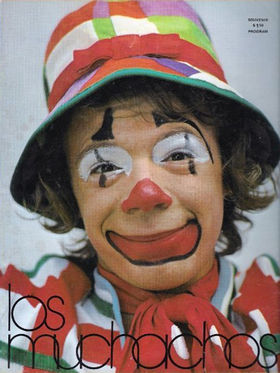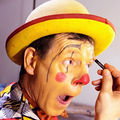Pancracio
From Circopedia
Clown
By Dominique Jando
Pancracio always wanted to be a clownGeneric term for all clowns and augustes. '''Specific:''' In Europe, the elegant, whiteface character who plays the role of the straight man to the Auguste in a clown team.—an augusteIn a classic European clown team, the comic, red-nosed character, as opposed to the elegant, whiteface Clown. to be specific—even before he saw his first circus. This dream was ingrained in him as a child; as he would say later, reflecting on his long and successful career, "El payaso nace, no se hace" (“One doesn’t become a clownGeneric term for all clowns and augustes. '''Specific:''' In Europe, the elegant, whiteface character who plays the role of the straight man to the Auguste in a clown team., one is born a clownGeneric term for all clowns and augustes. '''Specific:''' In Europe, the elegant, whiteface character who plays the role of the straight man to the Auguste in a clown team.”), a truism that has been uttered indeed by many a great clownGeneric term for all clowns and augustes. '''Specific:''' In Europe, the elegant, whiteface character who plays the role of the straight man to the Auguste in a clown team..
He was born Fernando Alvarez on July 29, 1955 in Jerez de la Frontera in the Province of Cádiz in Andalusia, in the Southern tip of Spain—a city famous worldwide for its sherry wine. Circus in Spain, during Fernando’s childhood, was at a peak, and it produced an array of extremely talented clowns who were stars in their own right: Pompoff y Thedy, Emy, Goti y Cañamon, the Andreu Rivels, Ramper, Popey, Los Hermanos Tonetti, among many others.
It was a fact Fernando couldn’t ignore. When he was in Primary School, the priest who taught him asked Fernando to draw an image of God on the blackboard; Fernando draw a clownGeneric term for all clowns and augustes. '''Specific:''' In Europe, the elegant, whiteface character who plays the role of the straight man to the Auguste in a clown team.. His epiphany eventually came when the Circo de los Muchachos visited Jerez. Created by a priest, Father Jesús Silva Mendez (1933-2011), the Circo de los Muchachos was an emanation of his Ciudad de los Muchachos (the Children’s City), which he had established in Benposta, near Orense in Galicia, in 1956.
A remarkable experiment, the Ciudad de los Muchachos was a refuge for destitute children, among whom many orphans, which was entirely run by the kids themselves as a children’s Republic. There was a mayor, a city government, and all the necessary professions were represented, all related activities being performed by the children. The only adult in the community was Father Silva. The foremost component of the Ciudad was the Escuela Nacional de Circo Los Muchachos, its circus school—and its performing arm, the Circo de los Muchachos, which gave the Ciudad an enormous publicity as well as much needed income.
El Circo de los Muchachos
Fernando was twelve when he joined the Muchachos’ circus school in 1967, where he was trained in all forms of basic acrobatics and other circus specialties, and was naturally cast as a clownGeneric term for all clowns and augustes. '''Specific:''' In Europe, the elegant, whiteface character who plays the role of the straight man to the Auguste in a clown team., under the name of Pancracio. In the late 1960s and early 1970s, the Circo de los Muchachos embarked into an international tour that took them all over Europe, and then to the United States, Colombia, Venezuela, Mexico, Senegal, the Ivory Coast, Cameroon, and Japan.Pancracio became the star of the show. Says Bernard de Fallois, the well-known French author and publisher: "His subtle sense of humor, his physical ability for acrobatics, the features of his face—which, if you actually look at them carefully, seem to exactly correspond to those of the ideal clownGeneric term for all clowns and augustes. '''Specific:''' In Europe, the elegant, whiteface character who plays the role of the straight man to the Auguste in a clown team.—all these elements brought the French photographer Edouard Boubat to dedicate to him many of his works as the circus performed in Paris in December of 1970."
This Paris visit proved important to Fernando: The Tout-Paris of the Arts feted the Circo de Los Muchachos, and the young Pancracio became the center of attention. There he befriended Annie Fratellini and Pierre Etaix, and many other French luminaries, met his future wife, and later, he would eventually settle in the French capital. But his international, peripatetic career was not over yet! Pancracio toured with Los Muchachos for about ten years. In 1976, he finally left The Muchachos, and went on a French tour with Annie Fratellini’s Nouveau Cirque de Paris. The following year, he created his own risley act, Los Pancracios, with which he appeared at Circo Price in Madrid, Circo Rinaldo Orfei in Italy, and in many variety shows and nightclubs in Spain.
In 1981, the great Spanish augusteIn a classic European clown team, the comic, red-nosed character, as opposed to the elegant, whiteface Clown. José Llata, who had just ended his association with Manolo Martini (Los Martini-Llata), asked Fernando and another Spanish augusteIn a classic European clown team, the comic, red-nosed character, as opposed to the elegant, whiteface Clown., Johny Diaz to join him and form a new trio, the Trio Llata. Together, they worked with the Spanish Circus Ringland, of the Raluy family, in a tour that took them to Western and Central Africa. At the end of this somewhat grueling adventure, José Llata, who was then sixty-seven years old, decided to retire. The trio disappeared and Fernando, who had married in the interval a French girl, Marie, whom he had met and fell in love with in 1970 when he was with the Muchachos at the Grand Palais, went back to Paris, where he settled definitely in 1983. (Fernando and Marie have two sons, Vladimir and Anton.)
Reaching Out
Pancracio continued to work as a solo clownGeneric term for all clowns and augustes. '''Specific:''' In Europe, the elegant, whiteface character who plays the role of the straight man to the Auguste in a clown team., working mostly dates and corporate events, notably for the Bougliones, and appearing in Paris with the Cirque Diana Moreno. He then went on to teach acrobatics and clowning at the Circus School of Montreuil, in the suburbs of Paris, and organized many successful circus and clown workshops in various French circus schools. Today Pancracio specializes in shows for children at risk or with disabilities, notably autistic children—a work for which he has developed a passion.
Bernard de Fallois sums up Pancracio’s work thus: "Through his professional experience as a clownGeneric term for all clowns and augustes. '''Specific:''' In Europe, the elegant, whiteface character who plays the role of the straight man to the Auguste in a clown team., Pancracio has developed a personal philosophy based on the power of laughter as a cure for pain and human suffering. He is convinced that people’s fascination with his art is because it shows the importance of being able to laugh at oneself, since the clown pretends to apprehend the world through the innocent eyes of a child. Consequently, failure is not supposed to be a reason for sadness or frustration, but rather for laughter and amusement. Indeed one of the main objectives of the clown is to remind adults of their lost curiosity and their fear of being ridiculous in front of other people, and to encourage them to not hesitate to laugh at themselves."








